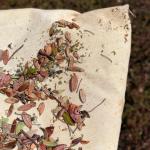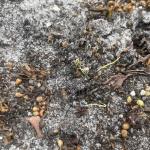To hear audio recording, call 508-258-9191.
No good sweeping days except this past Thursday (end of next week looks good too!). Many growers got out and found generally clean bogs. Just a few weevil here and there; few flies and spiders. Just a few very small green spanworm here and there. No treatable populations anywhere reported. Picture has 3 tiny green spanworm circled.
A few growers found tiny collembola (springtails) in the bottom of the nets - they are NOT a cranberry pest and eat garbage on bottom of bog (algae, pollen, fungi, etc.). Often you get many in a sweep set. They come in many colors: green, yellow, or brown. They are very small - 1-2 mm 1/10 the size of a cranberry leaf. Interesting but of no concern. (see picture of green collembola in sweep set).
Dodder has been reported in areas where berries are loaded but not on bog yet. Kerb applications should be made at early emergence of dodder seedlings (see photo). You may need to pull back the canopy to find seedlings. If you use Kerb, remember that you will need to submit a use report to MDAR by November. Forms will be available on our website once MDAR provides them to us.
Dodder picture courtsey of Thierry Besancon, Rutgers
We have a new SLN for Devrinol 2XT. It permits multiple and later applications of the herbicide on established plantings (the previous one was good for new plantings only). You can do 6-9 qt/A per application not to exceed 18 qt/A. Later timings could improve control of seed germination of warm-season perennials such as Poverty Grass. You can find the label here: https://ag.umass.edu/cranberry/services/special-pesticide-labels
Sprays for upright dieback should be made after the bud has broken dormancy (at bud break and/or early bud expansion) and has begun new growth. This is usually somewhere around mid-May but will vary by location and by variety. Be sure that the fungicide you are using (chlorothalonil or copper) is labeled for URD use. Not all fungicides (especially many of the generics) are labeled for URD. If the Phytophthora diagnosis is confirmed and bog drainage is improved, the first application could be made between April 25 and May 15. The spring application could slow down the infection. The ideal time for Phytophthora fungicide applications is when soil temperatures are conducive for root development and pathogen multiplication (May, June, July and August). Be sure you have a diagnosis for Phytophthora and improve your drainage before spending money on fungicides.
As of May 4, bud tolerance for Early Black and Howes is 27°F; for Ben Lear and Stevens it is 29.5°F. Note: starting with cabbage head stage, development continues even when visual stages appear not to change. Each stage, starting with cabbage head, only lasts 5-7 days!
We will be hosting a bogside workshop this Thursday May 12, from 8-10 am; 2 contact hours offered. The zoom link is: https://umass-amherst.zoom.us/j/98776457924.


